Design Interactions - Biotech brief
Workshop at IBE
Students and staff at the Design Interactions course at the Royal College of Art took part in a two day workshop at the Institute of Biomedical Engineering. The aim of the workshop was to provide those from the RCA with an embedded view upon biomedical technologies, and for those based at IBE to have a refreshed set of responses to their research.
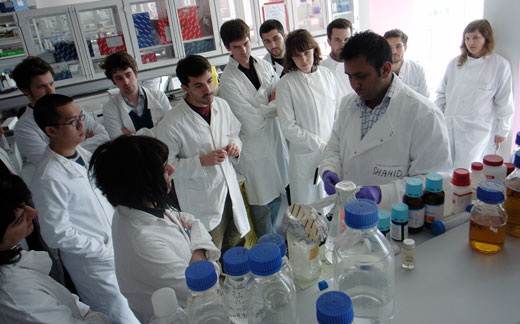 above: Shahid Aziz leads an experiment with Design Interaction students
above: Shahid Aziz leads an experiment with Design Interaction students
The workshop included an introduction and tour from Rob Fenton - Research Development Director at IBE - with presentations from Nick Oliver and Olive Murphy, and lab experiments lead by Shahid Aziz and Thao Le.
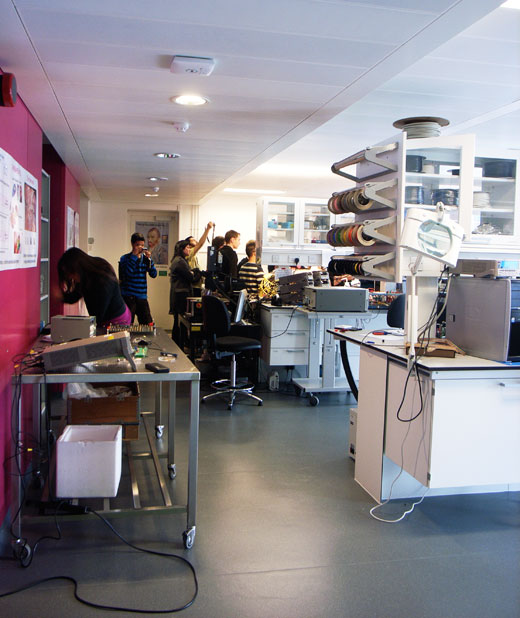 above: documenting a tour of the Institute of Biomedical Engineering
above: documenting a tour of the Institute of Biomedical Engineering
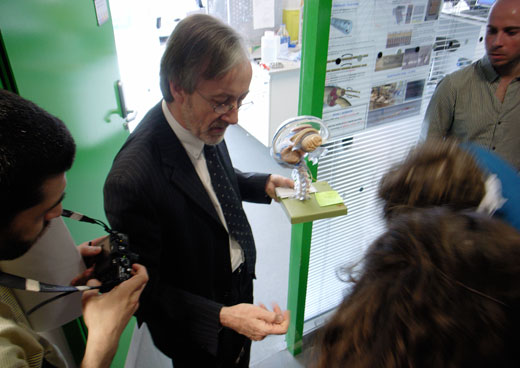 above: Rob Fenton shows an implant for transmiting electrical signals across damaged nerves
above: Rob Fenton shows an implant for transmiting electrical signals across damaged nerves
The brief
This kicked off a four week project for Design Interactions students, with researchers at IBE and Reading taking up visiting tutor roles at the RCA through tutorial sessions, providing feedback on the projects. A project blog was set up by Cesar, to share design materials and other start points.
A pdf of the brief is here. The aim was to connect designers fascination with and trepidation towards biotechnology with a mundane and situated understanding of lab based reseach, along with an awareness of contemporary science and society agendas.
Paul Thurston of Think Public (Paul comments on his vist here), Tom Shakespeare of PEALS and Alex Wilkie from Goldsmiths were invited to provide a programme of evening lectures for students to hear about how public sector work and sociology might broaden the exchange between biomedical engineering and reflective design.
Projects were developed and presented at a crit which was attended by Shahid, Nick and Olive. See some of these outcomes below, and track down Human Futures, a book published by FACT in Liverpool which documents a smaller selection of the students' projects.
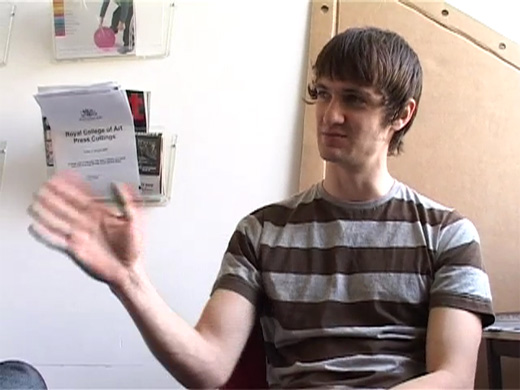 above: Austin describes his project during a tutorial with
Patrick Degenaar
and Tobie,
watch
Steve Jackman's short film of the conversation
above: Austin describes his project during a tutorial with
Patrick Degenaar
and Tobie,
watch
Steve Jackman's short film of the conversation
Outcomes of the brief
A selection of the final outcomes - documented by the students:
- Cathy the hacker
- Homegrown
- Microbe Controllers - Biological Landscaping at Home
- Homeostatic architecture
- Bio(drive)
- BioCredit
- Doctor Monitors
- Heart
- Plant+(*)
- Prospect Resort
- Ecstasy
- Risky Medicine
Cathy the hacker
Nelly Ben Hayoun

The project was finally done in two parts.
The first one explores how design can be a tool to communicate around subject such hard as euthanasia. I made "Imperfect objects" with the hypothesis that they will help me in a context of an interview to get information that I couldn't get if I was asking the question. The process was really foggy as I already planned my interview with a terminal ill nurse: Sue Morgan and Cathy Johns, working at the RCA library, that I met occasionally, without being sure of where I wanted to go and what would be the angle the conversation would take. When I was making these objects I didn't know what they were except the context that I wanted to purpose them.
I was surprised to see that both were answering positively to these strange tools, such as a Rorschach test, the objects brings them on areas that I wouldn't be able to bring "on the table". I had big hopes with these interviews before they had started. I was believing that they will generate content to help me to decide at the end what angle I wanted to explore more than an other. Also they were a way for me to make the subject less dramatic and start quickly to experiment.
From these interviews (Didier Hoch, Sue Morgan and Cathy Johns), I come back with the idea that biotech don't have its place in end of life. And that I should better focus on what I find very powerful in an act such as euthanasia which is expressing your free-will. You are free to decide when you want to end your life, nobody has to discuss that.
Healthcare nowadays is very stressful, lifespan has to be long, but sometimes what doctors purpose you is just not right as it reduces your free will.
To me, that's the main problem with the DNA analysis. We will be able to know when we are going to die, but do we really need this information? Isn't it a new need that pharmaceutics company create?
Also one you get an implant which send data all the time to your doctor, you're not free anymore, you can't take it off "once it's implanted it's always there" said Doctor Olive Murphy. Everything start to be predictable, but this is not human, your life is made of hazard and you might don't want to know for at least one hour what is going on in your body!
So the second part of the project explores how you can hack your blood pressure implant which somehow should expend your life but reduce it as well. This part was done with Doctor Olive Murphy who is creating that implant. That's was one of the best experience of this project, she completely get the idea of "one hour freedom" and explored what could be the different ways to hack her invention.
Also I decided to focus on a character such as Cathy Johns with very strong principles on what she wants and don't want from healthcare. Not everybody will react like her.
(additional project documentation here)
Homegrown
Will Carey
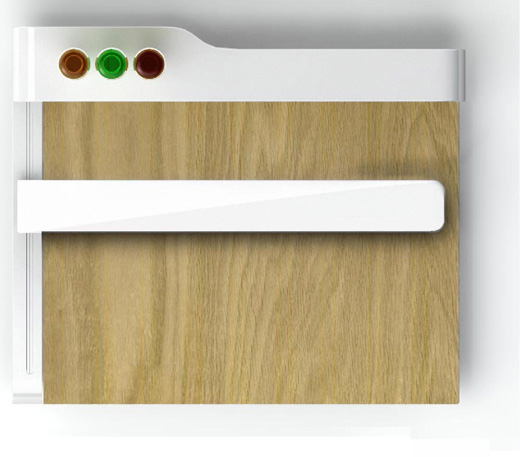
Sourcing local foods and keeping livestock have recently been portrayed as qualitative experiences. Though this invigorated appetite for foraging and rearing comes at a premium to shopping for food at a supermarket, this is about investing personal effort over a long period of time, in order to gain the freshest produce.
Homegrown began as an exploration of how the domestic production of vitro meat might sit within this context. How would cell culturing leave the laboratory and enter the home? Would methods of production at such small scales enable meat to be treated as a material, combining cells derived from a range of animals, creating compound or hybrid foods with unexpected textures and flavours? Scenarios were developed to suggest new aesthetics for food production, and novel rituals for preparing and tasting in vitro meats.
Microbe Controllers -
Biological Landscaping at Home
Daisy Ginsberg

Microbes are the enemy. We spend millions on anti-bacterial products, fear the microbes in our food, in our homes, on our hands. Yet with microbes in our body outnumbering our own cells, they might have more to offer than we thought. Escherichia coli - or E.coli - is the workhorse of the biotech lab and the model bacterium, having played a key role in the development of biotechnology. Easily manipulated and cultured in a laboratory, we probably know more about this lowly bacteria than any other living creature on earth. Craig Venter is fishing the world's oceans collecting millions of diverse microbes, prospecting for new strings of genetic code that may yield new and profitable commercial applications. Meanwhile, microbes are being genetically engineered to create biological computers, infiltrating the previously grey technology of silicon with a new green dimension.
This project considers domestic landscape where microbes and other engineered microscopic organisms cultivated to perform useful to tasks in the home. Aware of this microscopic horticultural landscape living alongside us, will our attitudes to what we accord 'living' status change? I am interested in the life now/mind later and life/mind same time debate: what are the ethical issues in making living, disposable consumer products? Are we duty-bound to develop biotechnologies and consider the ethics later? At what scale do we value life? In the lab, bacteria, neurons and other cellular scale 'things' are not attributed 'living' status, but as the size and complexity increases, we begin to feel more tenderness or anxiety towards the organisms involved in lab testing. But in the context of the current debate on stem cell embryonic research, this flexible value framework becomes really interesting. What do we consider alive? How do we decide this? Is their an emotional boundary, and how can we test it?
Should we be fighting for microbe rights? Cemeteries and memorials for dead kettles and expired lab cultures? Microbes may not have feelings - as far as we understand - but perhaps we should we explore the ethics of enslaving them before the Argos catalogue is filled with living electronics.
Homeostatic architecture
Cesar Harada
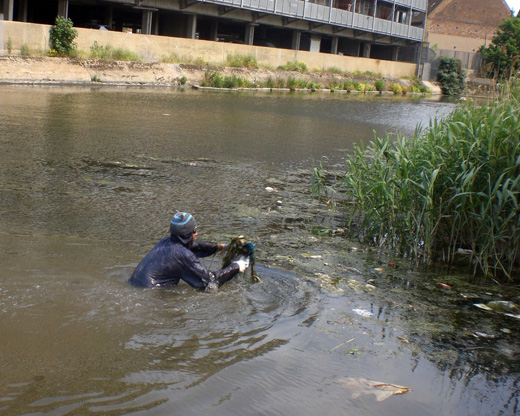
Rather than a finished object, the homeostatic architecture is a research process. I tried to understand how language (code) and life (bio) are connected in a behavioral system. Can behavior be architecture? : not architecture as goal, but architecture as action. Along the way I made 3 prototypes that landmarked the evolution of my architectural approach.
- Floating-vehicle-island : a bound network of organic (roots, branches), and information material (network cable for computer data) aggregated and maintained by human occupier.ins
- Floating debris robot-collector : an autonomous robot boat that senses and collects floating debris (organic and synthetic) its carburant, until it eventually biodegrades within what it has collected.
- Modified beaver : a commodified animal that collects intentionnally both organic and synthetic material to enhance its habitat, entirely biodegradable, reproduces, evolves.
I moved from trying to imitate life form capacities within my architecture to reprogramming existing life forms to generate (not my) architecture, pragmatic and free of socio-ethical considerations. Learning to think of a structure not as a finished object as it is constantly used, modified, under construction or destruction but rather think in terms of maintenance and evolution tactics for maintaining a livable organism.
Bio(drive)
Vanessa Harden

Bio(drive) is an exploration into the relationships that exist between members of different car cultures and their vehicles.
How do these relationships differ from group to group?
Among the different car cultures that I researched, I found the relationship between the racecar driver and his vehicle, as well as the relationship between the fans, the driver and the vehicle to be of particularly interest.
- What data do the car and driver produce during the race?
- How is this data translated?
- And how can it be used to enhance the experience of the fans?
These are amongst the questions that I have tried to address throughout this project.
BioCredit
Bernhard Hopfengaertner
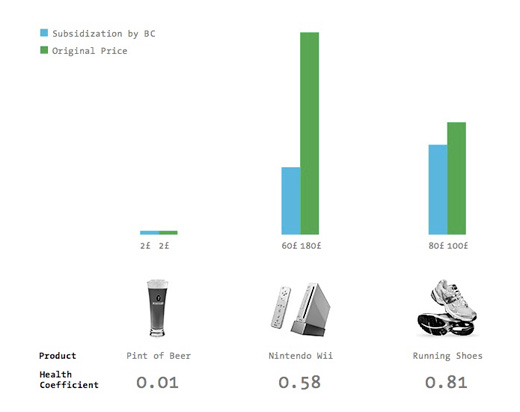
BioCredit is a service in between a health insurance and an entertainment/ life-style company. It is using the influence of life-style products on everyday live in order to create healthy habits for healthy people. This reduces the cost for medical treatment on the one hand and enables it to earn money in life-style products as well. At the same time the focus of medicine shifts from the idea of repairing to the idea of maintaining. This is facilitated by a positive feedback system which doesn't restrict the usage of unhealthy products but rewards the usage of healthy ones.
The concept of BioCredit is quiet close to reality, there are already health insurers that pay for the gym. The only difference is BioCredit is using a system that allows the idea of health to spread into all aspects of live and create strange hybrids.
That's why I made a video speaking about a film director that just won a major film festival, 10 years after BioCredit entered the market. The director is a pioneer of the bio film genre that started emerging along with Biocredits notion of health, throughout society. The director is speaking about a new freedom in film making since to the healthy aspect was being introduced to it. As people go to the cinemas not only for amusement but as well because of the healthy effect, they are willing to engage with much more experimental formats as long as they are supposed to be healthy. That gives the directors the possibility to explore new film languages while still being successful.
The topic of the video is quiet far away from the BioCredit itself. The reason for that is, that BioCredit is so close to reality and its mechanism of manipulation is so common that it is hardly visible as Critical Design Project, it could easily be the idea for a business plan. Going into the future and looking at something that doesn't seem to have anything to do with health or biotechnology can establish teh necessary distance and a perspective to examine what BioCredit is about. As well I thought, as a perspective on biotechnology the video is almost opposite to those playing a role in biotechnology, because it's not looking at the primary effects of these technologies but only on the side effects.
Doctor Monitors
Austin HouldsworthThe pressure on doctors and medical staff within hospitals to perform there duties to the highest standard is immense, but it is only correct to have a patient orientated health service. As new government targets and incentives are designed to give the patient better health care they inevitably place more pressure on the medical staff - which worsens there overall health. Stressed and tired medical staff will inevitably deliver poor medical care to the patients, so new cost effective bio-technologies have been employed to monitor the doctor and feed relevant information about there health to the patient.
The implemented Technologies:
- Orexin reactive ID badge
- Closed loop Orexin deliverance system
- Audio out stethoscope
- Adrenaline reactive Bleep
Heart
Cathrine Kramer

Death was once a decision left to fate, but now medical machines and modern technology make death a matter of decision. When is it time to pull the plug?
The line between humans and machines are becoming increasingly blurred. Is a steady heart beat all that's needed to constitute a life? When a loved one becomes dependant on a machine to stay alive, what relationships do we form with the machine?
My animation explores this space, assuming we create an emotional bond with the equipment and sounds that remind us of our loved one, even after the plug has been pulled.
I find this an interesting topic, and would like to take it further in future - perhaps through interviews - and start to develop these objects that replace the presence of a loved one.
Plant+(*)
Tommaso LanzaExploring future scenarios where the established relations between us and the vegetable life are fundamentally altered by current and possible biotechnology advancements.
Prospect Resort
Sascha Pohflepp
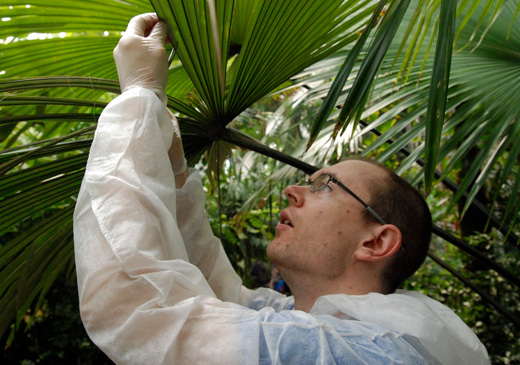
Bioprospecting describes the practice of collecting plant and animal life for possible use of their traits in research and often the development of new pharmaceutical products. Already common in colonial times, prospecting has recently gained in importance with synthetic biology and the various efforts of collecting and sequencing the genomes of a vast number of living organisms.
At the same time, biological research is becoming more accessible and affordable, often facilitated by the participatory culture of the internet. The amateur bioprospector, who is, much like amateur astronomers, feeding his or her findings back into a lively community, is becoming increasingly realistic. Yet, unlike in astronomy, those who dive into the subject will often have a personal investment in their activities. Many bioprospectors might be suffering from a degenerative disease like ALS or Parkinson's and may want to actively participate in the search for a cure while their illness progresses.
Prospect Resort is a fictional hotel in South America which provides these personal bioprospectors with a base for their ventures into the Amazon rainforest. Following a promising initial genetic discovery in one of the local species, the area might have experienced a gold-rush of hopeful individuals which makes Prospect Resort a possibility. Being hotel, high-grade laboratory and hospital in equal parts, it would be ideally located in one of the most biodiverse ecosystems of the planet. There, residents would, often accompanied by their families, search for specimen of rare plants and animals that have shown promising results in earlier research. The prospector's equipment mainly consists of a portable sterile laboratory cabinet and simple tools to take tissue samples with. However, a small local economy has also developed around the resort, with stalls selling mostly biopsies of small animals and plants from inaccessible areas in the forest.
Taking into account an emerging culture of amateur science, Prospect Resort as a proposal wants to also comment on what by some is seen as a form of contemporary colonialism. Its services are aimed at the future needs of the comparatively wealthy, but only reflect a general shift in popular culture where participation in the production of information-also relating to illness and death-might soon be considered the norm. However, there is a real opportunity for individuals to participate in genetic research in the near future, possibly even with the support of the public health system.
Ecstasy
Dot Samsen

"Laughter is the best medicine", specific medical theories attribute improved health, increased life expectancy, and overall improved well-being, to laughter. Biomedical engineering has developed to the level that all the NHS's chronic patients don't need to go to hospital to check their health condition. They can stay home with their personal health measure machine. Live their life with loneliness and all the numbers from the cold machine. Is it the quality of life that they want? The electric brain stimulator for laughter (EBSL) is a new technology that uses a very small electric current to stimulate specific part of brain to encourage laughter. Suitable for everyone, especially elderly, who want to be lively and healthy.
We extend our lifespan by combining our self more and more with machine, less and less to the human. What if something very uniquely to human such as laughter is not natural anymore? Longevity vs. happiness? Symbiosis of human and machine? Virtual or reality? What is its consequence?
Risky Medicine
Thomas Thwaites

I guess I did 2 projects which ended up actually being about the same thing; medical risk and society.
'Thousands' of people with chronic degenerative diseases have travelled to clinics in China and elsewhere to receive stem cell therapies which have not been approved in the United States, Britain and the majority of other 'western' countries. Though these therapies are viewed as unproven by the medical establishment, and as such potentially harmful or deadly, the people who undergo them have a different view of the risks and potential harm or benefits they could bring.
The image of the cruise ship chartered by the Alzeheimer's society was meant to highlight the problem of a society dictating acceptable action to people whose lives may hang in the balance. My design proposal was to monitor the effects of these untested treatments on people, using a simple and inexpensive biosenor (the Ninetendo Wii), and through the power of networks and statistics, perform a cumulative meta analysis on the data. This would then allow for the risk vs. reward of new treatments to be analysed 'in real time', and allow other patients to make their own choice as to whether they want to undergo an unapproved 'risky' therapy.
I also made a bracelet type 'device', through which blood could circulate,out of medical components I got from a 'Emergency Travel Kit' from Boots. I roped a good friend who's a Dr into actually taking blood from me and allowing it to circulate around the bracelet. The actual object itself I think was quite visually arresting, but it obviously proved to be controversial.
The video I made of the process, at my friend's flat, with his girlfriend doing the shaky camerawork was quite powerful and provoked quite a reaction. This I think was due to what is a medical process (taking blood) being preformed in a non-medical setting, and for non-medical reasons. Although in itself I don't think it was risky to do (a very minor standard procedure, with sterile equipment, with two trained doctors present), I believe the reaction to the video was evidence of a kind of fear about the workings of our own bodies, in part due to their medicalisation.
The reaction to bringing the object containing my clotted blood into college was also strong (i.e. it was very stupid), and I think valid. But it did serve to highlight that health and safety rules make no allowance for 'knowing' someone - they are made assuming the worst case.
Thanks from Material Beliefs to students and staff from Design interactions and the Institute of Biomedical Engineering.